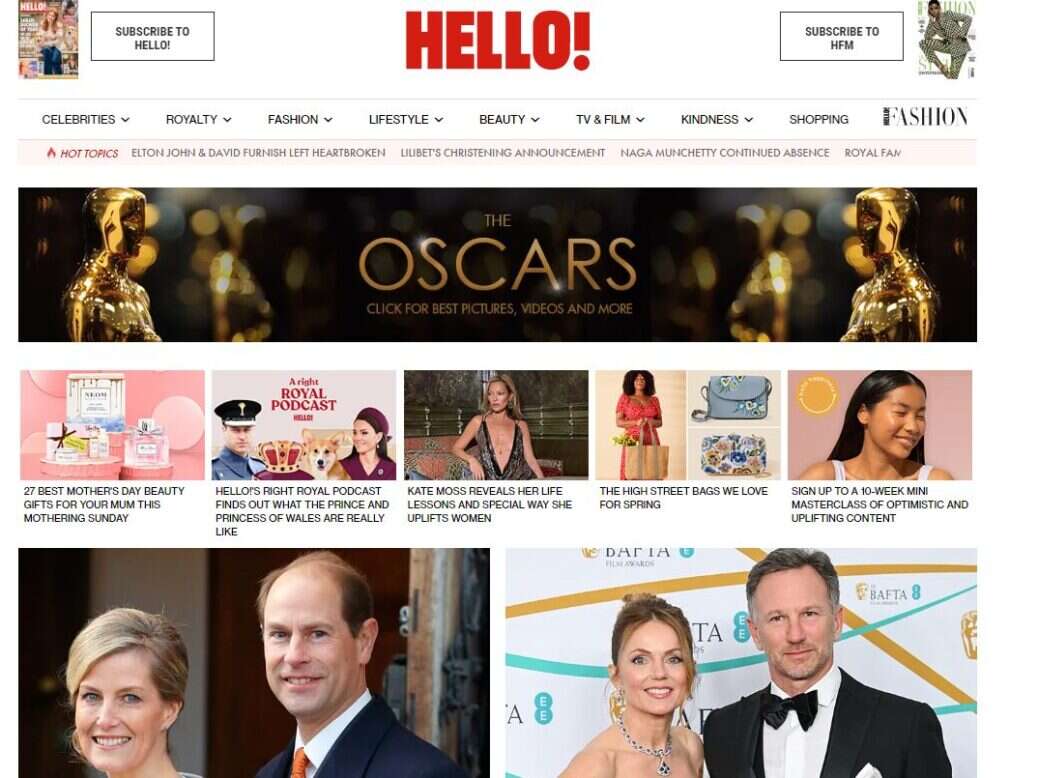
Hello! magazine is the UK’s most popular women’s publication online, according to a new ranking of women’s news and lifestyle websites by Press Gazette.
The celebrity, fashion and lifestyle brand, owned by Spanish parent company ¡Hola!, reached 8.5 million people in July – 17% of the UK online audience aged over 15 – although this was down 23% year-on-year.
It was followed by the website of Hearst-owned Good Housekeeping (audience of 4.7 million, up 2% year-on-year) and Reach’s OK! (3.9 million, down 24%).
Cosmopolitan, also owned by Hearst, was fourth (3.3 million people, down 50%), while Conde Nast’s Glamour UK (2.7 million people, up 21%) completed the top five according to the new Ipsos iris figures.
Most popular women’s news and magazine websites in the UK (monthly audience):
- Hello! Magazine (8.5 million)
- Good Housekeeping (4.7 million)
- OK! (3.9 million)
- Cosmopolitan (3.3 million)
- Glamour UK (2.7 million)
- Women’s Health (2.3 million)
- Marie Claire (2 million)
- British Vogue (2 million)
- Stylist (1.6 million)
- Woman and Home (1.4 million)
Cosmopolitan UK editor-in-chief Claire Hodgson told Press Gazette earlier this year that while print remains integral to the brand, Cosmopolitan is “a really thriving digital business” and a “very strong digital brand”.
Twenty of the 28 women’s brands in our ranking for which year-on-year change data is available saw audience decline in July.
At the same time, the women’s print magazine sector has been shrinking almost across the board. Cosmopolitan UK’s total circulation has declined by 70% in the past ten years, falling to an average of 120,495 in 2022 according to ABC data, while Elle UK’s circulation declined by 53% in the past decade to 81,032. Other titles such as Glamour and In Style have dropped their print editions altogether.
The highest-ranked digital native brand in the ranking was Tyla, from Manchester-based social publisher Ladbible group. Tyla’s website and app reached 1.2 million people in the UK in July (down 15% year-on-year).
Press Gazette used Ipsos iris’ ranking of the top 2100 online brand groups and selected the biggest magazine and news brands which, in our view, are consumed by a majority female audience. It should be noted, however, that some websites on our list may no longer be thought of as strictly for women and may appeal to men or LGBTQ+ audiences as well.
US women’s beauty publication Allure saw the biggest growth with its UK audience up 31% year-on-year to 483,029. The Conde Nast title went digital-only this year after publishing its final print edition in December 2022.
Glamour UK, Who What Wear (1.1 million, up 19%), Prima (750,113, up 12%), She Knows (591,004, up 10%) and Byrdie (576,795, up 10%) were the other five brands to see double-digit growth. Good Housekeeping and Sheerluxe (607,349, up 1%) saw audience growth in the single figures.
The biggest year-on-year audience falls were recorded for Heat World (628,323, down 79%), Elle (814,757, down 59%), Closer (617,608, down 58%) and Bustle (727,761, down 56%).
By page views, Hello! (31.4 million page views), Good Housekeeping (16.7 million) and OK! (16.6 million) took the top three spots, as with total audience.
The same three brands also dominated for total minutes spent with their content, although OK! overtook Good Housekeeping on this metric. Hello! was well ahead with 43.5 million minutes, with the others on 15.2 million and 13.9 million minutes respectively.
Tyla (rank four for page views and rank three for time spent), however, came first for average number of minutes spent with its content per user (6 minutes 56 seconds) ahead of second-placed Sheerluxe (5 minutes 38 seconds).
Men's sector
Among the Ipsos iris list of over 2,000 top online brands in the UK by audience size (covering all online sectors), we could only filter out a handful which could be explicitly defined as men's lifestyle. We excluded titles covering topics such as gadgets, tech and motoring.
Top-ranked was Conde Nast's British GQ (audience of 1.6 million, up 13% year-on-year) followed by Men's Health (1.4 million, down 13% year-on-year) and Esquire (880,202, down 33%).
Despite ranking second for reach, Men's Health was top for engagement, with audiences spending a combined 4.6 million minutes with its content in July compared to 3.3 million for British GQ. There were also 3.5 million page views to the brand, again ahead of British GQ (2.5 million).
Ipsos iris replaced Comscore as the industry-recognised standard in 2021. Ipsos iris data is partly derived from a panel of 10,000 people aged 15 and over that is designed to be nationally representative. The participants have meters installed across 25,000 personal devices to passively measure website and app usage.
This is combined with data from participating websites that are tagged so all devices visiting the site can be identified and logged.
Email pged@pressgazette.co.uk to point out mistakes, provide story tips or send in a letter for publication on our "Letters Page" blog
